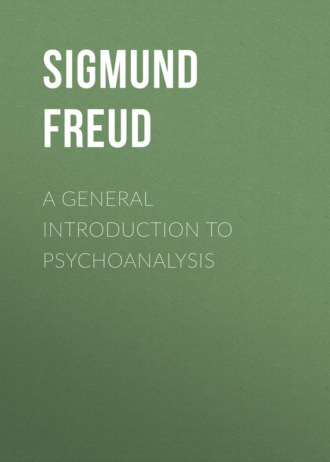 полная версия
полная версияA General Introduction to Psychoanalysis
Allow me to pass over the other trivial incidents of this ritual; they would teach us nothing new and cause too great digression from our purpose. Do not overlook, however, the fact that all this does not run its course quite smoothly. Everything is pervaded by the anxiety that things have not been done properly; they must be examined, repeated. Her doubts seize first on one, then on another precaution, and the result is that one or two hours elapse during which the girl cannot and the intimidated parents dare not sleep.
These torments were not so easily analyzed as the compulsive act of our former patient. In the working out of the interpretations I had to hint and suggest to the girl, and was met on her part either by positive denial or mocking doubt. This first reaction of denial, however, was followed by a time when she occupied herself of her own accord with the possibilities that had been suggested, noted the associations they called out, produced reminiscences, and established connections, until through her own efforts she had reached and accepted all interpretations. In so far as she did this, she desisted as well from the performance of her compulsive rules, and even before the treatment had ended she had given up the entire ritual. You must also know that the nature of present-day analysis by no means enables us to follow out each individual symptom until its meaning becomes clear. Rather it is necessary to abandon a given theme again and again, yet with the certainty that we will be led back to it in some other connection. The interpretation of the symptoms in this case, which I am about to give you, is a synthesis of results, which, with the interruptions of other work, needed weeks and months for their compilation.
Our patient gradually learns to understand that she has banished clocks and watches from her room during the night because the clock is the symbol of the female genital. The clock, which we have learned to interpret as a symbol for other things also, receives this role of the genital organ through its relation to periodic occurrences at equal intervals. A woman may for instance be found to boast that her menstruation is as regular as clockwork. The special fear of our patient, however, was that the ticking of the clock would disturb her in her sleep. The ticking of the clock may be compared to the throbbing of the clitoris during sexual excitement. Frequently she had actually been awakened by this painful sensation and now this fear of an erection of the clitoris caused her to remove all ticking clocks during the night. Flowerpots and vases are, as are all vessels, also female symbols. The precaution, therefore, that they should not fall and break at night, was not without meaning. We know the widespread custom of breaking a plate or dish when an engagement is celebrated. The fragment of which each guest possesses himself symbolizes his renunciation of his claim to the bride, a renunciation which we may assume as based on the monogamous marriage law. Furthermore, to this part of her ceremonial our patient adds a reminiscence and several associations. As a child she had slipped once and fallen with a bowl of glass or clay, had cut her finger, and bled violently. As she grew up and learned the facts of sexual intercourse, she developed the fear that she might not bleed during her bridal night and so not prove to be a virgin. Her precaution against the breaking of vases was a rejection of the entire virginity complex, including the bleeding connected with the first cohabitation. She rejected both the fear to bleed and the contradictory fear not to bleed. Indeed her precautions had very little to do with a prevention of noise.
One day she guessed the central idea of her ceremonial, when she suddenly understood her rule not to let the pillow come in contact with the bed. The pillows always had seemed a woman to her, the erect back of the bed a man. By means of magic, we may say, she wished to keep apart man and wife; it was her parents she wished to separate, so to prevent their marital intercourse. She had sought to attain the same end by more direct methods in earlier years, before the institution of her ceremonial. She had simulated fear or exploited a genuine timidity in order to keep open the door between the parents' bedroom and the nursery. This demand had been retained in her present ceremonial. Thus she had gained the opportunity of overhearing her parents, a proceeding which at one time subjected her to months of sleeplessness. Not content with this disturbance to her parents, she was at that time occasionally able to gain her point and sleep between father and mother in their very bed. Then "pillow" and "wooden wall" could really not come in contact. Finally when she became so big that her presence between the parents could not longer be borne comfortably, she consciously simulated fear and actually succeeded in changing places with her mother and taking her place at her father's side. This situation was undoubtedly the starting point for the phantasies, whose after-effects made themselves felt in her ritual.
If a pillow represented a woman, then the shaking of the featherbed till all the feathers were lumped at one end, rounding it into a prominence, must have its meaning also. It meant the impregnation of the wife; the ceremonial, however, never failed to provide for the annulment, of this pregnancy by the flattening down of the feathers. Indeed, for years our patient had feared that the intercourse between her parents might result in another child which would be her rival. Now, where the large pillow represents a woman, the mother, then the small pillow could be nothing but the daughter. Why did this pillow have to be placed so as to form a rhomb; and why did the girl's head have to rest exactly upon the diagonal? It was easy to remind the patient that the rhomb on all walls is the rune used to represent the open female genital. She herself then played the part of the man, the father, and her head took the place of the male organ. (Cf. the symbol of beheading to represent castration.)
Wild ideas, you will say, to run riot in the head of a virgin girl. I admit it, but do not forget that I have not created these ideas but merely interpreted them. A sleep ritual of this kind is itself very strange, and you cannot deny the correspondence between the ritual and the phantasies that yielded us the interpretation. For my part I am most anxious that you observe in this connection that no single phantasy was projected in the ceremonial, but a number of them had to be integrated, – they must have their nodal points somewhere in space. Observe also that the observance of the ritual reproduce the sexual desire now positively, now negatively, and serve in part as their rejection, again as their representation.
It would be possible to make a better analysis of this ritual by relating it to other symptoms of the patient. But we cannot digress in that direction. Let the suggestion suffice that the girl is subject to an erotic attachment to her father, the beginning of which goes back to her earliest childhood. That perhaps is the reason for her unfriendly attitude toward her mother. Also we cannot escape the fact that the analysis of this symptom again points to the sexual life of the patient. The more we penetrate to the meaning and purpose of neurotic symptoms, the less surprising will this seem to us.
By means of two selected illustrations I have demonstrated to you that neurotic symptoms carry just as much meaning as do errors and the dream, and that they are intimately connected with the experience of the patient. Can I expect you to believe this vitally significant statement on the strength of two examples? No. But can you expect me to cite further illustrations until you declare yourself convinced? That too is impossible, since considering the explicitness with which I treat each individual case, I would require a five-hour full semester course for the explanation of this one point in the theory of the neuroses. I must content myself then with having given you one proof for my assertion and refer you for the rest to the literature of the subject, above all to the classical interpretation of symptoms in Breuer's first case (hysteria) as well as to the striking clarification of obscure symptoms in the so-called dementia praecox by C. G. Jung, dating from the time when this scholar was still content to be a mere psychoanalyst – and did not yet want to be a prophet; and to all the articles that have subsequently appeared in our periodicals. It is precisely investigations of this sort which are plentiful. Psychoanalysts have felt themselves so much attracted by the analysis, interpretation and translation of neurotic symptoms, that by contrast they seem temporarily to have neglected other problems of neurosis.
Whoever among you takes the trouble to look into the matter will undoubtedly be deeply impressed by the wealth of evidential material. But he will also encounter difficulties. We have learned that the meaning of a symptom is found in its relation to the experience of the patient. The more highly individualized the symptom is, the sooner we may hope to establish these relations. Therefore the task resolves itself specifically into the discovery for every nonsensical idea and useless action of a past situation wherein the idea had been justified and the action purposeful. A perfect example for this kind of symptom is the compulsive act of our patient who ran to the table and rang for the maid. But there are symptoms of a very different nature which are by no means rare. They must be called typical symptoms of the disease, for they are approximately alike in all cases, in which the individual differences disappear or shrivel to such an extent that it is difficult to connect them with the specific experiences of the patient and to relate them to the particular situations of his past. Let us again direct our attention to the compulsion neurosis. The sleep ritual of our second patient is already quite typical, but bears enough individual features to render possible what may be called an historic interpretation. But all compulsive patients tend to repeat, to isolate their actions from others and to subject them to a rhythmic sequence. Most of them wash too much. Agoraphobia (topophobia, fear of spaces), a malady which is no longer grouped with the compulsion neurosis, but is now called anxiety hysteria, invariably shows the same pathological picture; it repeats with exhausting monotony the same feature, the patient's fear of closed spaces, of large open squares, of long stretched streets and parkways, and their feeling of safety when acquaintances accompany them, when a carriage drives after them, etc. On this identical groundwork, however, the individual differences between the patients are superimposed – moods one might almost call them, which are sharply contrasted in the various cases. The one fears only narrow streets, the other only wide ones, the one can go out walking only when there are few people abroad, the other when there are many. Hysteria also, aside from its wealth of individual features, has a superfluity of common typical symptoms that appear to resist any facile historical methods of tracing them. But do not let us forget that it is by these typical symptoms that we get our bearings in reaching a diagnosis. When, in one case of hysteria we have finally traced back a typical symptom to an experience or a series of similar experiences, for instance followed back an hysterical vomiting to its origin in a succession of disgust impressions, another case of vomiting will confuse us by revealing an entirely different chain of experiences, seemingly just as effective. It seems almost as though hysterical patients must vomit for some reason as yet unknown, and that the historic factors, revealed by analysis, are chance pretexts, seized on as opportunity best offered to serve the purposes of a deeper need.
Thus we soon reach the discouraging conclusion that although we can satisfactorily explain the individual neurotic symptom by relating it to an experience, our science fails us when it comes to the typical symptoms that occur far more frequently. In addition, remember that I am not going into all the detailed difficulties which come up in the course of resolutely hunting down an historic interpretation of the symptom. I have no intention of doing this, for though I want to keep nothing from you, and so paint everything in its true colors, I still do not wish to confuse and discourage you at the very outset of our studies. It is true that we have only begun to understand the interpretation of symptoms, but we wish to hold fast to the results we have achieved, and struggle forward step by step toward the mastery of the still unintelligible data. I therefore try to cheer you with the thought that a fundamental between the two kinds of symptoms can scarcely be assumed. Since the individual symptoms are so obviously dependent upon the experience of the patient, there is a possibility that the typical symptoms revert to an experience that is in itself typical and common to all humanity. Other regularly recurring features of neurosis, such as the repetition and doubt of the compulsion neurosis, may be universal reactions which are forced upon the patient by the very nature of the abnormal change. In short, we have no reason to be prematurely discouraged; we shall see what our further results will yield.
We meet a very similar difficulty in the theory of dreams, which in our previous discussion of the dream I could not go into. The manifest content of dreams is most profuse and individually varied, and I have shown very explicitly what analysis may glean from this content. But side by side with these dreams there are others which may also be termed "typical" and which occur similarly in all people. These are dreams of identical content which offer the same difficulties for their interpretation as the typical symptom. They are the dreams of falling, flying, floating, swimming, of being hemmed in, of nakedness, and various other anxiety dreams that yield first one and then another interpretation for the different patients, without resulting in an explanation of their monotonous and typical recurrence. In the matter of these dreams also, we see a fundamental groundwork enriched by individual additions. Probably they as well can be fitted into the theory of dream life, built up on the basis of other dreams, – not however by straining the point, but by the gradual broadening of our views.
EIGHTEENTH LECTURE
GENERAL THEORY OF THE NEUROSES
Traumatic Fixation – The UnconsciousI SAID last time that we would not continue our work from the standpoint of our doubts, but on the basis of our results. We have not even touched upon two of the most interesting conclusions, derived equally from the same two sample analyses.
In the first place, both patients give us the impression of being fixated upon some very definite part of their past; they are unable to free themselves therefrom, and have therefore come to be completely estranged both from the present and the future. They are now isolated in their ailment, just as in earlier days people withdrew into monasteries there to carry along the burden of their unhappy fates. In the case of the first patient, it is her marriage with her husband, really abandoned, that has determined her lot. By means of her symptoms she continues to deal with her husband; we have learned to understand those voices which plead his case, which excuse him, exalt him, lament his loss. Although she is young and might be coveted by other men, she has seized upon all manner of real and imaginary (magic) precautions to safeguard her virtue for him. She will not appear before strangers, she neglects her personal appearance; furthermore, she cannot bring herself to get up readily from any chair on which she has been seated. She refuses to give her signature, and finally, since she is motivated by her desire not to let anyone have anything of hers, she is unable to give presents.
In the case of the second patient, the young girl, it is an erotic attachment for her father that had established itself in the years prior to puberty, which plays the same role in her life. She also has arrived at the conclusion that she may not marry so long as she is sick. We may suspect she became ill in order that she need not marry, and that she might stay with her father.
It is impossible to evade the question of how, in what manner, and driven by what motives, an individual may come by such a remarkable and unprofitable attitude toward life. Granted of course that this bearing is a general characteristic of neurosis, and not a special peculiarity of these two cases, it is nevertheless a general trait in every neurosis of very great importance in practice. Breuer's first hysterical patient was fixated in the same manner upon the time when she nursed her very sick father. In spite of her recuperation she has, in certain respects, since that time, been done with life; although she remained healthy and able, she did not enter on the normal life of women. In every one of our patients we may see, by the use of analysis, that in his disease-symptoms and their results he has gone back again into a definite period of his past. In the majority of cases he even chooses a very early phase of his life, sometime a childhood phase, indeed, laughable as it may appear, a phase of his very suckling existence.
The closest analogies to these conditions of our neurotics are furnished by the types of sickness which the war has just now made so frequent – the so-called traumatic neuroses. Even before the war there were such cases after railroad collisions and other frightful occurrences which endangered life. The traumatic neuroses are, fundamentally, not the same as the spontaneous neuroses which we have been analysing and treating; moreover, we have not yet succeeded in bringing them within our hypotheses, and I hope to be able to make clear to you wherein this limitation lies. Yet on one point we may emphasize the existence of a complete agreement between the two forms. The traumatic neuroses show clear indications that they are grounded in a fixation upon the moment of the traumatic disaster. In their dreams these patients regularly live over the traumatic situation; where there are attacks of an hysterical type, which permit of an analysis, we learn that the attack approximates a complete transposition into this situation. It is as if these patients had not yet gotten through with the traumatic situation, as if it were actually before them as a task which was not yet mastered. We take this view of the matter in all seriousness; it shows the way to an economic view of psychic occurrences. For the expression "traumatic" has no other than an economic meaning, and the disturbance permanently attacks the management of available energy. The traumatic experience is one which, in a very short space of time, is able to increase the strength of a given stimulus so enormously that its assimilation, or rather its elaboration, can no longer be effected by normal means.
This analogy tempts us to classify as traumatic those experiences as well upon which our neurotics appear to be fixated. Thus the possibility is held out to us of having found a simple determining factor for the neurosis. It would then be comparable to a traumatic disease, and would arise from the inability to meet an overpowering emotional experience. As a matter of fact this reads like the first formula, by which Breuer and I, in 1893-1895, accounted theoretically for our new observations. A case such as that of our first patient, the young woman separated from her husband, is very well explained by this conception. She was not able to get over the unfeasibility of her marriage, and has not been able to extricate herself from this trauma. But our very next, that of the girl attached to her father, shows us that the formula is not sufficiently comprehensive. On the one hand, such baby love of a little girl for her father is so usual, and so often outlived that the designation "traumatic" would carry no significance; on the other hand, the history of the patient teaches us that this first erotic fixation apparently passed by harmlessly at the time, and did not again appear until many years later in the symptoms of the compulsion neurosis. We see complications before us, the existence of a greater wealth of determining factors in the disease, but we also suspect that the traumatic viewpoint will not have to be given up as wrong; rather it will have to subordinate itself when it is fitted into a different context.
Here again we must leave the road we have been traveling. For the time being, it leads us no further and we have many other things to find out before we can go on again. But before we leave this subject let us note that the fixation on some particular phase of the past has bearings which extend far beyond the neurosis. Every neurosis contains such a fixation, but every fixation does not lead to a neurosis, nor fall into the same class with neuroses, nor even set the conditions for the development of a neurosis. Mourning is a type of emotional fixation on a theory of the past, which also brings with it the most complete alienation from the present and the future. But mourning is sharply distinguished from neuroses that may be designated as pathological forms of mourning.
It also happens that men are brought to complete deadlock by a traumatic experience that has so completely shaken the foundations on which they have built their lives that they give up all interest in the present and future, and become completely absorbed in their retrospections; but these unhappy persons are not necessarily neurotic. We must not overestimate this one feature as a diagnostic for a neurosis, no matter how invariable and potent it may be.
Now let us turn to the second conclusion of our analysis, which however we will hardly need to limit subsequently. We have spoken of the senseless compulsive activities of our first patient, and what intimate memories she disclosed as belonging to them; later we also investigated the connection between experience and symptom and thus discovered the purpose hidden behind the compulsive activity. But we have entirely omitted one factor that deserves our whole attention. As long as the patient kept repeating the compulsive activity she did not know that it was in any way related with the experience in question. The connection between the two was hidden from her, she truthfully answered that she did not know what compelled her to do this. Once, suddenly, under the influence of the cure, she hit upon the connection and was able to tell it to us. But still she did not know of the end in the service of which she performed the compulsive activities, the purpose to correct a painful part of the past and to place the husband, still loved by her, upon a higher level. It took quite a long time and a great deal of trouble for her to grasp and admit to me that such a motive alone could have been the motive force of the compulsive activity.
The relation between the scene after the unhappy bridal night and the tender motive of the patient yield what we have called the meaning of the compulsive activity. But both the "whence" and the "why" remained hidden from her as long as she continued to carry out the compulsive act. Psychological processes had been going on within her for which the compulsive act found an expression. She could, in a normal frame of mind, observe their effect, but none of the psychological antecedents of her action had come to the knowledge of her consciousness. She had acted in just the same manner as a hypnotized person to whom Bernheim had given the injunction that five minutes after his awakening in the ward he was to open an umbrella, and he had carried out this order on awakening, but could give no motive for his so doing. We have exactly such facts in mind when we speak of the existence of unconscious psychological processes. Let anyone in the world account for these facts in a more correct scientific manner, and we will gladly withdraw completely our assumption of unconscious psychological processes. Until then, however, we shall continue to use this assumption, and when anyone wants to bring forward the objection that the unconscious can have no reality for science and is a mere makeshift, (une façon de parler), we must simply shrug our shoulders and reject his incomprehensible statement resignedly. A strange unreality which can call out such real and palpable effects as a compulsion symptom!











